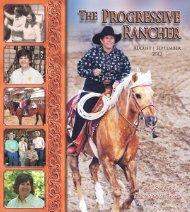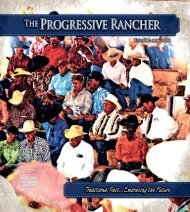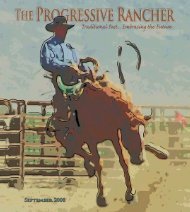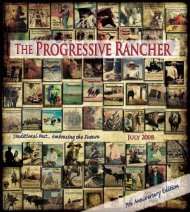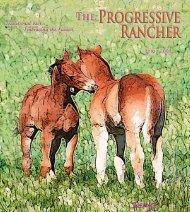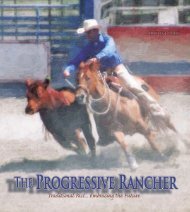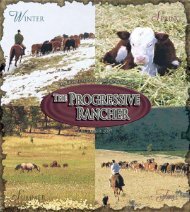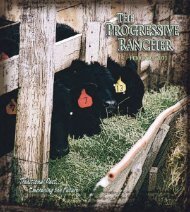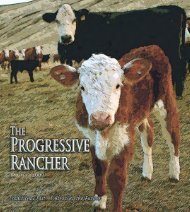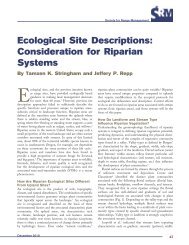NCA 2009 President's Award Recipient - The Progressive Rancher ...
NCA 2009 President's Award Recipient - The Progressive Rancher ...
NCA 2009 President's Award Recipient - The Progressive Rancher ...
Create successful ePaper yourself
Turn your PDF publications into a flip-book with our unique Google optimized e-Paper software.
Canada Thistle<br />
Background Photo: UAF Cooperative Extension Archive, University of Alaska – Fairbanks, Bugwood.org<br />
Canada thistle rosette.<br />
Individual Canada thistle plants.<br />
Canada thistle flower.<br />
Hello from the Humboldt Watershed Cooperative<br />
Weed Management Area! This month we would like<br />
to introduce you to another state listed noxious weed, Canada<br />
Thistle (Cirsium arvense). Though its name would indicate<br />
otherwise, Canada thistle is a native of the Mediterranean region<br />
and southeast Europe. It likely was introduced into North<br />
America in contaminated hay and grain seed during early<br />
colonization in the 17th century. Canada thistle has become<br />
very well established in North America and is now considered<br />
a noxious weed in at least 35 states and much of Canada.<br />
Canada thistle usually grows 2 to 3 feet tall with alternate,<br />
dark green leaves that vary in size. <strong>The</strong> leaves are generally<br />
oblong, the length 3 to 5 times the width, usually deeply lobed,<br />
and have spiny toothed edges. <strong>The</strong> leaf edge spines vary in size<br />
and number according to variety. Canada thistle is a perennial<br />
spreading both by seed and underground rhizomes. It generally<br />
forms colonies and is found in cropland, roadsides, and disturbed<br />
pasture soils. However, Canada thistle is not very competitive in<br />
healthy turf.<br />
Canada thistle grows best in the northern regions of North<br />
America where temperature and rainfall are moderate. Canada<br />
thistle rosettes require at least 14 hours of day length to bolt and<br />
flower. Its growth is limited or stopped when temperature exceed<br />
85° F for extended periods. Although it will grow in a wide range<br />
of soils, Canada thistle produces deeper roots in clay or muck soils<br />
than in sand or gravel.<br />
Once the plant becomes established, roots are the most important<br />
means of propagation. Canada thistle has an extensive<br />
underground root system that may penetrate the soil to a depth of<br />
10 feet or more and grow laterally 12 to 15 feet per year. Root buds<br />
occur randomly along the roots and initiate new shoots whenever<br />
environmental conditions are favorable. Root segments as small as<br />
0.6 inch can initiate shoot growth and become established.<br />
<strong>The</strong> key principle to Canada thistle control is to stress the<br />
plant and force it to use stored root nutrients. Canada thistle can<br />
recover from almost any stress, including control attempts, because<br />
of root nutrient stores. <strong>The</strong>refore, returning infested land to<br />
a productive state occurs only over time. Success requires a sound<br />
management plan implemented over several years.<br />
Cultural control. Grasses and alfalfa can compete effectively<br />
with Canada thistle if their growth is favored by good management.<br />
Maintain fertility and, if possible, moisture at optimum<br />
levels to favor grass or alfalfa growth. Soil analysis can easily<br />
determine fertility needs. Be cautious with nitrogen fertilizers,<br />
because excess available soil nitrogen may favor weed growth.<br />
<strong>The</strong>se are essential management steps to ensure optimum desirable<br />
plant growth and<br />
competition. However,<br />
competition alone seldom<br />
is effective against<br />
Canada thistle.<br />
Mechanical control. Mowing<br />
hay meadows can be an effective<br />
tool if combined with herbicide treatments.<br />
Mowing alone is not effective unless conducted<br />
at one-month intervals over several growing<br />
seasons. Always combine mowing with cultural and<br />
chemical control. Mowing at hay cutting stimulates new<br />
Canada thistle shoots to develop from its root system.<br />
Chemical control. Read the label, follow directions and use<br />
precautions. Research has shown that Tordon 22K (picloram),<br />
Milestone (aminopyralid), Transline (clopyralid), Banvel/ Vanquish/Clarity<br />
(dicamba) and Telar (chlorsulfuron) are effective<br />
against Canada thistle. Canada thistle is difficult to control and retreatment<br />
for one to three or more years after the initial application<br />
is common. Refer to following table for use rates and application<br />
timing. <strong>The</strong>se herbicides are most effective when combined with<br />
cultural and/or mechanical control.<br />
Please notify the HWCWMA if you see Canada thistle<br />
growing along the Humboldt River. Our staff can provide the<br />
property owner or appropriate public agency with site-specific<br />
advice on how best to remove it. We have an opportunity to stop it<br />
from spreading if we act quickly. We map all known locations of<br />
regulated noxious weeds in order to help us and others locate new<br />
infestations in time to control them.<br />
<strong>The</strong> Humboldt Watershed CWMA has also developed a website<br />
to serve as a clearinghouse for information on weeds in the<br />
Humboldt Watershed. Our website (http://www.humboldtweedfree.org)<br />
contains fact sheets for state listed noxious weeds in<br />
Nevada, Board of Director’s information, funding partner’s links,<br />
and many more features including a detailed project proposal<br />
packet that you can print, fill out and mail back to us at your convenience.<br />
We are looking to expand our project area outside of the<br />
Humboldt River and always welcome new funding opportunities<br />
and partnerships.<br />
If you have any questions, please feel free to contact Andi<br />
Porreca, HWCWMA Coordinator at (775) 762-2636 or email<br />
her at aporreca@humboldtweedfree.org. Or you may speak with<br />
Rhonda Heguy, HWCWMA President at (775) 738-3085, email:<br />
hwcwma@gmail.com.<br />
Herbicide to control Canada thistle in pastures, rangeland, natural and noncrop areas.<br />
Herbicide<br />
Rate<br />
Application timing<br />
Comments<br />
(Production/A)<br />
Tordon 1 quart Anytime when weeds are rapidly growing Fall applications consistent results; may need re-treatment 1 to 2 years<br />
Milestone 5 to 7 fl oz Spring at prebud growth stage; or fall Use higher rate for older or dense stands; Milestone may be used to<br />
edge of ponds or streams; may need re-treatment 1 to 2 years<br />
Transline 0.67 to 1.33 pints Spring after all shoots have emerged, Apply 1 pint/A or more in fall; may need re-treatment 1 to 3 years<br />
rosette to early bud growth stages; or fall<br />
Telar 1 oz Spring bolting to bud growth stages; or fall Fall applications most consistent results; essential to use non-ionic<br />
surfactant at 0.25% v/v; may need retreatment 1 to 2 years<br />
Banvel, Vanquish, or<br />
Clarity (diacamba)<br />
2 quarts Spring rosette growth stage; or fall Fall applications most consistent results; may need re-treatment 2 to 4 years<br />
www.progressiverancher.com <strong>The</strong> <strong>Progressive</strong> <strong>Rancher</strong><br />
April 2013 35



